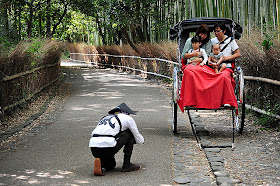PEACE
IN THE PARK NARA
Open space providing beautiful colors at the end of the fall,text by Renny Yaniar, photos
were taken from google, by darmansjah godjali.
Verdant grass like carpet. Trees with large girth, which also shows its age, a fence. Strong branches combined with foliage that displays beautiful colors. In the
center, the lake reflects the
surrounding landscape. Meanwhile, the sun provides warmth on
a cold day in late autumn.
I was enjoying Nara Park, about 1.5 hour bus ride from Osaka, occupies the northeast of the city. Green open space of about three and
a half times that of the football complex in Madrid Santiagou Barnebau is established since 1880. Not only exudes beauty flora, garden exhaling peace. Young and old, men
and women, to families of students in
uniform looks so vibrant despite the winter
winds begin to address.
Todai-ji temple buddha forms
are located in Nara park was amazing
The lovers of the open
space that not only play with others. Among them are those who are interested in observing or interacting with a herd of sika deer that inhabit the park. Animal enthusiasts
of this plant is already accustomed to the
crowds. The deer came to the Japanese mainland in the Ice Age passing among men pleasure. For visitors who come from far away, the deer become the
object of an eternal companion in the
picture - a picture together.
I deplore the
behavior of visitors to feed the tame deer herd. Addition will interfere with digestion, deer are ruminant mammals. I was stroking his chest when he saw an old lady handed
me a tissue and immediately eat a deer. Something that is
unacceptable imitated!
So why would they be allowed
to roam free? The deer is a symbol of Nara. According to legend, the god who fell to earth riding a white deer, and since then, the deer was considered sacred. Killing deer is considered the incarnation of the god could be sentenced to death. But
after World War II, no longer
considered sacred deer but became a
protected species. In fact, deer become 'a national treasure' for the Japanese. Perhaps, it is this which encourages parents advocate children feed the deer. Around the park, there are
many vendors who provide visitors biscuit that can be purchased as a feed.
Nara-koen not the only attractions.
However, Nara becomes a
window. There are a lot of art during China, Korea, and ancient India, even Persian. That's why,
at the
north end of the city Nara River valley is always crowded with tourists.
Just a few steps from the northwest Nara Park, Todaiji Temple there, which are 16 meters tall
Buddha statue. This is the world's largest bronze statue. In addition, there
are other temples, such as Kofuku-ji, Saidai-ji, Kasuga Tisha Shrine, and Shin Yakushi-ji.
About five miles to the west of the city center are Toshoda-ji temple. Cult building which was built in the center of the school's
759 Buddha Ritsu.
Do not miss Horyu-ji
Temple was founded by Prince Shotoku in 607. Temple complex, which hold more than
2,300 historical objects has gained the status of world heritage sites of Unesco. Learning culture is certainly exciting. Moreover, while enjoying a
variety of flowers.
LOGISTICS
Transportation: When using Japan Railways train line, take the train Miyakoji which operates every thirty minutes and will cost about USD90 from between Kyoto and Nara station. When choosing Kintetsu line, of Kyoto only takes about 35 minutes (about USD18)
Accommodation: There Nara Hotel (from $ 250), Asukaso (from USD275) Nara Washington Hotel (from USD55). Hotel Fujita Nara (from USD65) Hotel Nikko Nara (from USD 125).











